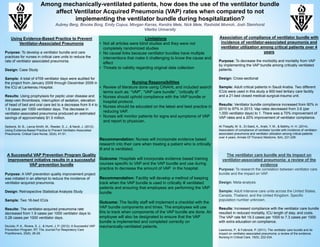
Poster
- 1. Among mechanically-ventilated patients, how does the use of the ventilator bundle affect Ventilator Acquired Pneumonia (VAP) rates when compared to not implementing the ventilator bundle during hospitalization? Aubrey Berg, Brooke Borg, Emily Copus, Morgan Karras, Kendra Mele, Nick Mele, Rashidat Momoh, Josh Steinhorst Viterbo University Using Evidence-Based Practice to Prevent Ventilator-Associated Pneumonia Purpose: To develop a ventilator bundle and care practices for nurses in critical care units to reduce the rate of ventilator associated pneumonia. Design: Case Study Sample: A total of 4709 ventilator days were audited for the project from January 2009 through December 2009 in the ICU at Lankenau Hospital. Results: Using prophylaxis for peptic ulcer disease and deep-vein thrombosis, interruption of sedation, elevation of head of bed and oral care led to a decrease from 9.4 to 1.9 cases per 1000 ventilator days. The decrease in ventilator-associated pneumonia produced an estimated savings of approximately $1.5 million. Sedwick, M. B., Lance-Smith, M., Reeder, S. J., & Nardi, J. (2012). Using Evidence-Based Practice to Prevent Ventilator-Associated Pneumonia. Critical Care Nurse, 32(4), 41-51. Limitations • Not all articles were blind studies and they were not completely randomized studies • No causal links because ventilator bundles have multiple interventions that make it challenging to know the cause and effect • Threats to validity regarding original data collection Nursing Responsibilities • Review of literature done using CINAHL and included search terms such as: “VAP”, “VAP care bundle”, “critically ill” • Nurses should uphold compliance with the VAP bundle or hospital protocol. • Nurses should be educated on the latest and best practice in reducing VAP. • Nurses will monitor patients for signs and symptoms of VAP and report to physician. Recommendation: Nurses will incorporate evidence based research into their care when treating a patient who is critically ill and is ventilated. Outcome: Hospitals will incorporate evidence based training courses specific to VAP and the VAP bundle and use during practice to decrease the amount of VAP in the hospital. Recommendation: Facility will develop a method of keeping track when the VAP bundle is used in critically ill ventilated patients and ensuring that employees are performing the VAP bundle. Outcome: The facility staff will implement a checklist with the VAP bundle components and times. The employees will use this to track when components of the VAP bundle are done. An employee will also be designated to ensure that the VAP bundle is implemented and completed correctly on mechanically-ventilated patients. The ventilator care bundle and its impact on ventilator-associated pneumonia: a review of the evidence Purpose: To research the correlation between ventilator care bundle and the impact on VAP. Design: Meta-analysis Sample: Adult intensive care units across the United States, Canada, Thailand, and the United Kingdom. Specific population number unknown. Results: Increased compliance with the ventilator care bundle resulted in reduced mortality, ICU length of stay, and costs. The VAP rate fell 19.3 cases per 1000 to 7.3 cases per 1000 with extra education on compliance. Lawrence, P., & Fulbrook, P. (2011). The ventilator care bundle and its impact on ventilator-associated pneumonia: a review of the evidence. Nursing In Critical Care, 16(5), 222-234. Association of compliance of ventilator bundle with incidence of ventilator-associated pneumonia and ventilator utilization among critical patients over 4 years Purpose: To decrease the morbidity and mortality from VAP by implementing the VAP bundle among critically ventilated patients. Design: Cross-sectional Sample: Adult critical patients in Saudi Arabia. Two different ICUs were used in this study a 900-bed tertiary care facility and a 21-bed closed medical-surgical-trauma unit. Results: Ventilator bundle compliance increased from 90% in 2010 to 97% in 2013. Vap rates decreased from 3.6 (per 1,000 ventilator days) to 1. There was a 70% improvement of VAP rates and a 20% improvement of ventilator compliance. Al-Thaqafy, M. S., El-Saed, A., Arabi, Y. M., & Balkhy, H. H. (2014). Association of compliance of ventilator bundle with incidence of ventilator- associated pneumonia and ventilator utilization among critical patients over 4 years. Annals Of Thoracic Medicine, 9(4), 221-226. A Successful VAP Prevention Program Quality improvement initiative results in a successful VAP prevention bundle Purpose: A VAP prevention quality improvement project was initiated in an attempt to reduce the incidence of ventilator-acquired pneumonia. Design: Retrospective Statistical Analysis Study Sample: Two 16-bed ICUs Results: The ventilator-acquired pneumonia rate decreased from 1.9 cases per 1000 ventilator days to 0.28 cases per 1000 ventilator days. DeJulio, P. A., Rivera, S. J., & Huml, J. P. (2012). A Successful VAP Prevention Program. RT: The Journal For Respiratory Care Practitioners, 25(6), 26-29.